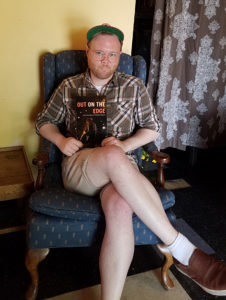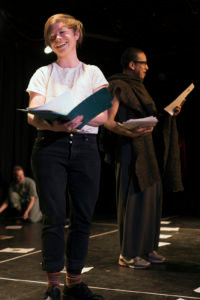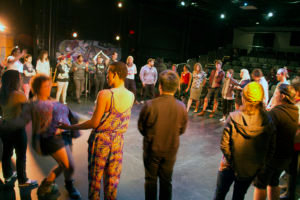By JAN WILLMS
For more than 30 years, Patrick’s Cabaret has been a fueling force for artists working on the edge. But its life is coming to an end, and a FUNeral will be held Sun., June 3 to commemorate and celebrate its years of existence.
Photo right: Patrick’s Cabaret building at Lake & Minnehaha circa 1999. (Photographer unknown. This snapshot is housed in the Tretter Collection at the UMN.)
The event will be held at 7:30pm at LUSH, 990 Central Ave. NE, featuring artists who have had a variety of history with Patrick’s Cabaret. Linda Miller, who performed in 1986, when the Cabaret first opened, will be at the closing party to offer a toast.
“Artists with a more recent history and who represent a newer generation will also be on hand,” said Scott Artley, the current executive artistic director of Patrick’s Cabaret. He said the FUNeral, which is described as a funeral, only funner, will explore the breadth of Patrick’s Cabaret. Printed copies of the organization’s just-published retrospective book “Out on the Edge: three decades of Patrick’s Cabaret” will be available at the FUNeral.
Patrick’s Cabaret is a queer-led performing arts incubator supporting the growth and development of artists on the edge of culture.
Founded by Patrick Scully, the cabaret started in St. Stephen’s School in Whittier in 1986 and in 1999 moved to its location at 3010 Minnehaha Ave. It remained at that location through May 2016.
 Photo left: Scott Artley holding a copy of the organization’s just-published retrospective book “Out on the Edge: three decades of Patrick’s Cabaret.” It will be available at the FUNeral. (Photo by Jan Willms)
Photo left: Scott Artley holding a copy of the organization’s just-published retrospective book “Out on the Edge: three decades of Patrick’s Cabaret.” It will be available at the FUNeral. (Photo by Jan Willms)
“When we lost the building we decided our best course of action was to become a mobile organization, working with partners,” Artley said. Scully left Patrick’s Cabaret in 2008 to pursue his own work. Artley came on board in January 2014 to serve part-time as a performing arts curator. “I was pretty much in charge of all the performing programs that we had, and I did that for two years,” he said. “In 2016 I became the executive artistic director, adding the managerial and administrative part to what I had already been doing.”
After leaving the Minnehaha location, Patrick’s Cabaret offered performances at a variety of venues throughout the Twin Cities. “We also developed other services and programs, working with artists in new ways,” Artley explained. “We actually served more than twice the number of artists we used to on two-thirds of the budget.”
 Photo right: Symone Smash-It in “Controlled Burn: queer performance for a world on fire” in 2016 at Intermedia Arts. (Photo by Ari Newman)
Photo right: Symone Smash-It in “Controlled Burn: queer performance for a world on fire” in 2016 at Intermedia Arts. (Photo by Ari Newman)
He said the organization maintained a couple of desks at Intermedia Arts, but that space was lost in November 2017. Artley has been th
e only full-time employee, but he has been assisted by an associate director working half-time, a program assistant working ten hours a week, and four interns working at various levels. “So I have a team, which is great,” Artley added.
“One of the things I changed starting in 20114 as performing arts curator was to revamp our cabaret program, which was the signature program that we had been doing since 1986,” he said. “I focused on having themed events, sort of a thread between different acts, which made appearances feel more cohesive and made the artist feel more connected to each other. I think audiences really enjoyed seeing performances that had a connecting line between all of them.”
 Photo left: Kat Purcell & Marcel Michelle-Mobama, co-producers of “Lightning Rod” 2018 at the Phoenix Theater. (Photo by Ari Newman)
Photo left: Kat Purcell & Marcel Michelle-Mobama, co-producers of “Lightning Rod” 2018 at the Phoenix Theater. (Photo by Ari Newman)
Artley said the guest curator program was something that had been done for a while. “I sort of expanded how we brought in other artists, curating and producing their own shows. So basically a year ago I stopped curating shows and really became support for a cohort of curators who were in charge of their own shows.”
“We also started a thing called Controlled Burn, queer performance for a world on fire. It was named after the practice of controlled burning on the prairie to promote new growth. We did that in December 2016, 18 acts of queer performance, right after the election when emotions were still pretty raw.”
Another new program started under the cabaret umbrella was one called Lightning Rod, described as a radical performance of experimentation where a group of about 35 artists came together. “We had writers, directors, and performers, creating new work that was inspired by what was happening that week. Everyone met on Sunday, and by Friday we had six new pieces or performances that were written, directed and performed within that week,” Artley said.
The name Lightning Rod came from a phrase that kept coming up, according to Artley. He said people would often ask “What is Patrick’s Cabaret?” He said the answer he kept hearing was “Patrick’s Cabaret has always been a lightning rod for the electricity in the air.”
“We have always been a home for some of the more electric performers in town, and a space to have some of the harder conversations about what is going on in our world. So Lightning Rod felt like a very apt name for these events that drew from what was happening this week and what artists had to say about it.”
 Photo right: Participants of “Lightning Rod” in 2017 at Intermedia Arts. (Photo by Ari Newman)
Photo right: Participants of “Lightning Rod” in 2017 at Intermedia Arts. (Photo by Ari Newman)
Patrick’s Cabaret also had a program called Raw Material, previously called the Calof Series. It provided a space for artists to try showing their works in progress and having an audience discussion about it. Starting in 2017, Patrick’s Cabaret artists worked with members of the Aliveness Project, a community center for and driven by people living with HIV.
But even with its many programs and performances, Patrick’s Cabaret has been struggling since losing its building on Minnehaha. “It was just becoming increasingly difficult for us to find sources of stable funding that would allow us to be what we want to be,” Artley said. “Our financial predictions in January said we would go into the red in August. Closing with such advance notice has meant we could have one last amazing season and go out on our own terms, looking like what we want to look like and doing what we want to do.”
“There will no longer be a Patrick’s Cabaret except in memory,” he said. “But there is really a lot of interesting stuff happening in the Twin Cities.”
Artley said there had been conversations monthly since February about what can be done to create an environment where artists who are on the edge of culture can thrive. “These conversations have been beautiful and truthful. We have our last one in mid-June.”
Artley said things are being done to move the legacy of Patrick’s Cabaret forward. The Controlled Burn program has been transferred to the 20% Theatre. Programs are moving forward with Soo VAC, an agency that has been a partner in artist education and professional development. Patrick’s Cabaret is creating a toolkit for Lightning Rod with Springboard for the Arts so that anybody can create their own version of that program. And, archives from Patrick’s Cabaret are being donated to the University of Minnesota.
“It has been a really exciting and challenging time to lead this organization, and I’m proud of the work we have done. I wish we could keep going. We are not closing because we want to, but because there is no other way forward that we think really honors the history of Patrick’s Cabaret,” said Artley. “I am grateful to everyone who has made this organization happen so far, to all the people who have made this platform exist for the last three decades.”
A Message from Patrick Scully about the closing of Patrick's Cabaret
Thirty-two years ago I organized a performance in the vast, airy gym on the first floor of St Stephen’s School in Whittier. It began with an idea, fueled only by passion and talent.
That event grew into Patrick’s Cabaret. In hundreds of shows since then, serving thousands of artists, observed by myriads of audience members, there is much to celebrate. Creating and sharing art is humanity at its best. It builds community. It reminds us of our common humanity. It celebrates our differences. I believe Patrick’s Cabaret helped to promote the democratization of our cultural community locally. That I cherish.
Patrick’s Cabaret spent a decade in a storefront (now Open Eye Theatre) on 24th St. in the Philips Neighborhood. There it evolved from an off-the-radar cultural renegade to an essential part of the Twin Cities arts ecosystem.
The arrival of Patrick’s Cabaret on Minnehaha Ave. just off Lake St. in Longfellow in 1999 was an important part of the renewal of that neighborhood. Now bustling, that intersection used to be so quiet on a Friday evening, that you would not have been surprised to see a ball of sagebrush roll down the road. After we arrived, things took off.
I am indebted to the neighborhood groups, both the Longfellow Neighborhood Association and the Longfellow Business Association for their support. I am glad to see the Hook & Ladder Theater continuing the tradition of performances in the old firehouse.
It saddens me that Patrick’s Cabaret is being closed.
Comments
No comments on this item Please log in to comment by clicking here